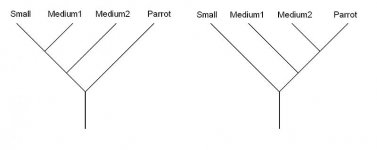(the pollen maps are not very useful, as pollen can blow hundreds of km easily).
Ok, thanks--that was the missing piece of info, then.
Fairly safe to assume that Parrot Crossbills colonised Britain with Scots Pine; also very likely that Common Crossbill never successfully colonised Britain until spruce and larch plantations started maturing in the mid to late 1700s.
Fairly safe, then, to assume that crossbills colonised Britain with
Pinus sylvestris.
But various southern European/North African populations are associated to
Pinus spp, and are not called "Parrots": still unsafe IMO to assume "association to
Pinus" = "Parrot Crossbill" outside the range of
pytyopsittacus. (Southern populations not as extreme morphologically as
pytyopsittacus; but this morphology possibly, if not probably, a more or less direct consequence of sympatry with a small-billed form; few Scottish specimens known to have shown this extreme morphology except in the last two decades.)
Jurek said:
We know that Parrot Crossbils have no problem flying in and breeding from Scandinavia.
Yep.
Citing Lindsay once again: "
It is now fairly evident that many of the birds that DNT and Alan Knox referred to as "Scottish Crossbill" are in fact what we today call "Parrot Crossbill" here in Scotland" and "
Parrot Crossbill is the only real candidate for being the relict Caledonian species - an isolated population of Parrot Crossbill." If true, these Scottish breeding birds have always been there; and if they have always been there, what is the evidence that they flew in from Scandinavia?
(I don't say that it never happens, of course; but you take it as a proven, and I just don't believe that this can be done.)
The obvious case to look for is any future development of a thin-billed crossbill adapted to the small cones of Sitka Spruce Picea sitchensis (the most abundant species in UK plantations).
The problem being that, should this ever happen, we would probably just suddenly "know" that crossbills have no problem flying in and breeding from the Altai...





